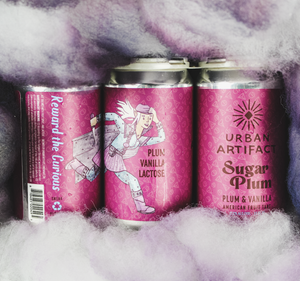Let’s cut to the chase before the digression begins. Simply put, the Midwest Fruit Tart Ale is a style defined by a few key factors: intense real fruit flavor and aroma which is balanced by a moderate to high clean lactic acidity, moderate to high level of alcohol, and a malt profile designed to enhance and support the profoundly decadent nature of these beers. Light funk from wild yeast or wood fermentation characteristics is acceptable but not present in most examples. Beers falling into this category may be considered as liquid embodiments of a Fruit Tart, with balance, explicit articulation of genuine fruit flavors and indulgence apparent upon even casual assessment. Originally crafted here in the Midwest, some prime examples are: New Glarus Raspberry Tart, New Glarus Serendipity, Streetside Raspberry Beret, Nine Giant Happiness is all the Rage, Urban Artifact The Gadget, Squeezebox, Palmistry, and Fire Iron, etc. (please email me if you want me to add another beer to the list. bret@artifactbeer.com)
What the Midwest Fruit Tart style isn’t has as much to say about the beer as what the style is. This style isn’t defined by aggressive, over the top acidity; the kind that makes your teeth feel fuzzy (there is another style established for that beer experience!). There should be no natural or artificial flavorings or extracts and no use of artificial coloring agents (this really applies to every beer, IMO, but to each their gross own). Back sweetening with sugar is not necessary given the levels of real fruit needed to achieve the hallmarks of the style. Balancing lactic acidity from the beginning prevents the need for this and avoids what would surely be an overly sweet mess.
So, how do you brew this style of beer? Well, like anything, techniques are going to vary from brewer to brewer, but here are a few good tips for you that will help to create world class Midwestern Fruit Tart beers:
- Use real fruit. Whole fruit single strength purees are a great way for the brewer to save on the labor required to process fresh whole fruit. If you are planning on using whole fruit, frozen (IQF) is a great alternative to fresh as the fruit is picked at peak freshness and frozen at the farm, where fresh fruit is often picked unripe and shipped/ripened simultaneously.
- Make sure you use literally tons of fruit. Depending on the fruit, you should start at least at 1 lb/gal. Depending on pricing and how naturally intense the flavor of the fruit is to begin with, we vary from 1 lb./ gallon for explicit fruits, such as raspberries, up to 3+ lb/ gallon for more delicate examples, like strawberries and blueberries!. (Yes, we have used over 3,000lbs of fruit in a 1,000 gallon batch before! ). Passion fruit may be used effectively at levels as low as .5lb/gal and make a big impact. Also, make sure to add your fruit to your fermentor, rather than your boil kettle or mash tun; doing so will keep as many of the finer aromatics intact as possible.
- Focus on an extremely controlled acidification, employing the same sanitary standards one would for a typical yeast fermentation. Select a strain of lactobacillus in the same way you would a beer yeast; consider the parameters of your brewery, fermentation control and desired outcome in terms of flavor and aroma. I highly recommend a dedicated souring vessel over using a mash tun or boil kettle. If you must use the mash tun or kettle however, make sure you take a couple precautions into consideration. Firstly, eliminate oxygen exposure. You can bubble CO2, or other relatively inert gases, through the bottom of your vessel if you must. This keeps flavors such as cheese and vomit out of your beer. Keep fermentation temperatures below 100 F (we’ve had success fermenting in the mid 70s). Additionally, use a fresh pitch of isolated lactobacillus; you aren’t going to get consistency when you are inoculating with grains.
- Put the focus on balance and drinkability. The fruit provides a lot of perceived sweetness, so these beers can handle a high amount of acidity to help balance it out. Additionally, by keeping caramel malts in check, you can further increase drinkability and balance in the beer. Hop bitterness should be low since your balance is coming from the tartness and bitterness generally clashes with acidity.
That’s enough to get you started. There are some advanced techniques that we will cover in a future Wild Pitch. Hit me up if you have any questions about brewing your own Midwest Fruit Tart Ale at bret@artifactbeer.com
Ok, let’s have some fun and run the Midwestern Fruit Tart style through the 2017 Brewer’s Association Style Guidelines format:
Midwest Fruit Tart Beer
Color: Can range from pale to very dark depending on the fruit used. Impact from malt should have a comparatively minimal impact on the color, as the fruit(s) used should be the ultimate driver. It should be obvious if real fruit was used rather than extracts or flavorings.
Clarity: Generally hazy from the massive amount of fruit used. Clear is acceptable if filtered, but generally only translucent even post filtration.
Perceived Malt Aroma & Flavor: Not perceived to medium-low
Perceived Hop Aroma & Flavor: Not perceived to medium-low
Fermentation Characteristics: Midwest Fruit Tart Beers are fermented with traditional American, English, or German ale or lager yeast. Acidic bacterial fermentation characteristics should be present and contribute clean, lactic acidity and enhance overall balance. Acetic fermentation characteristics should not be evident, as these are more reflective of traditional sour beers. Wild yeast fermentation characteristics, if present, should add depth of flavor and complexity but not detract from balance or cover up flavors derived from fruit.
Body: Medium to Full
Additional Notes: Fruit aromas, ranging from moderate to intense, should be evident and not overpowered by hop or wild fermentation aromas. Fruit should be obviously real fruit, extracts and flavorings are not acceptable. Acidity should not overpower, but instead enhance and provide balance to an otherwise fruity beer. Any perceived sweetness should come from the fruit, rather than from any back sweeteners.
Digression
Craft beer has a long history in America of beer style innovation, bending, and creativity. Liquid American ingenuity at work, with brewers large, small, and at home across our great land revitalizing and redefining what beer is on a world scale. No longer must we cower at the proverbial Brewer’s Table in conversations with the world’s great brewing cultures, Belgium, Germany, and England. For in today’s world we bring a new spirit of growth, freedom, and creativity, unbound by silly “progressive” tax laws or “purity” laws (silly Germans and their bizarre “purity” obsession).
This craft beer renaissance has led to a litany of new craft beer styles, with more coming about seemingly every year. It started rather innocently with “American” twists on classic English styles. American Pale Ale, American IPA, American Stout, American Brown Ale, etc. Basically, it began as taking a traditional European style and punching it up a notch with more alcohol and often more hops. This bled into American Wheat beers, American Red Ales, and American spiced holiday ales, the biggest spice offenders being Pumpkin and Christmas beers.
Take, for example, the evolution of the American IPA: originally descended from the English IPA, brewers honed their craft and started pushing flavor intensity. As a natural progression, the double and triple IPA were born. Overly bitter, overly hoppy, and overly alcoholic, it was a practice in freedom and liberty (‘murica). From there, brewers pulled back, hit the brakes a bit and, before you could blink, the Session IPA was thrust upon America’s welcoming bosom. What was basically little more than an overly hoppy pale ale swept the country, and some innovative brewers thought to themselves, “Hell, I can do that and take it to the next level”. And again, a new style, the New England IPA, was birthed. Intensely hop flavored but light on the bitterness, this style was born to push the boundaries of hop expression in a beer while keeping the bitterness in check to enhance drinkability.
Similar to these styles, the Midwestern Fruit Tart style was being produced before accurate terminology to describe it existed. Sure, the BJCP covers fruit beers, sour beers, and the combination of the two, however, there is no standing distinction for fruited beers with a specifically clean and balanced lactic acid tartness. This quality keeps Midwestern Fruit Tarts out of the fruit beer and traditional sour category (which is typically seen as having a more robust and ‘sour’ acid profile). So, in an effort to avoid diluting the definitions of established styles, the Midwestern Fruit Tart style was born.
It’s exciting to think about what the future holds for the innovation of American craft beer. Tomorrow lies in the imagination of bold and intrepid brewers who are willing to take radical new ideas and ask simply ‘Why not’?
Cheers,
Bret Kollmann Baker
Chief of Brewing Operations








